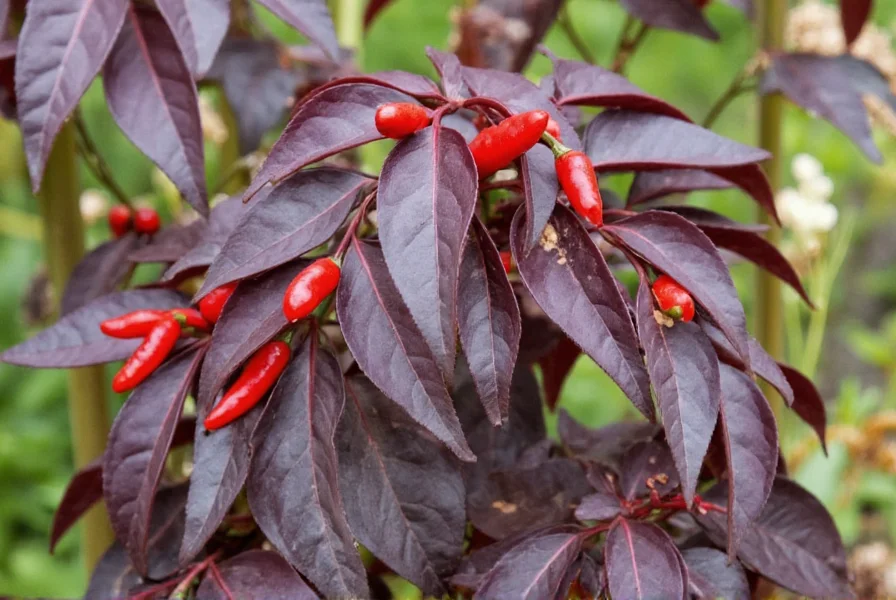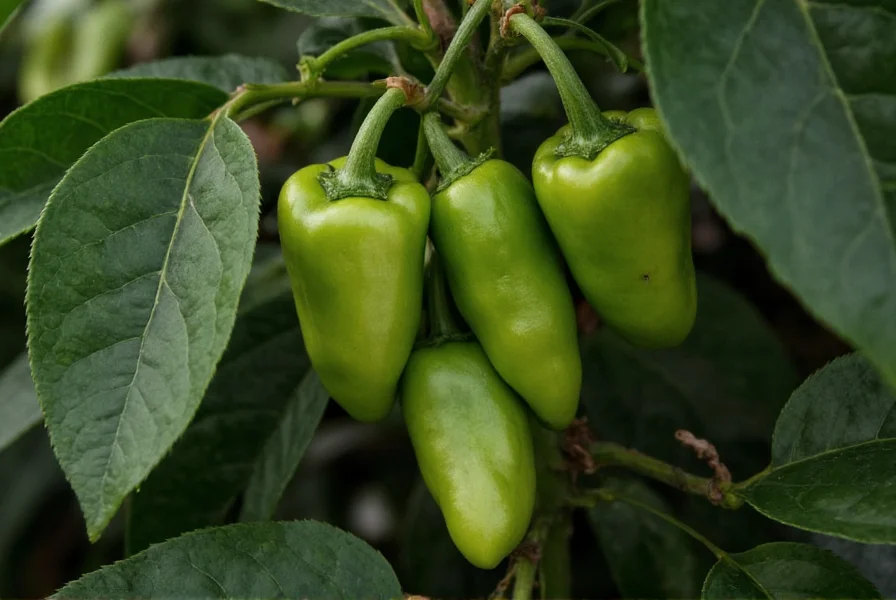The Gotham Ivy Pepper has rapidly gained popularity among gardeners seeking both visual drama and culinary versatility. Unlike many purely ornamental varieties, this pepper offers the rare combination of stunning aesthetics and usable harvest. Its deep purple to near-black leaves create a sophisticated backdrop for the bright red, cherry-shaped peppers that grow upright on the plant—a distinctive feature that sets it apart from most pepper varieties where fruits hang downward.

Botanical Characteristics and Visual Appeal
Gotham Ivy Pepper belongs to the Solanaceae family and is a cultivar of Capsicum annuum. What makes this variety particularly noteworthy is its exceptional foliage coloration. The leaves emerge green but quickly develop rich purple-black pigmentation as the plant matures, creating a dramatic contrast with the glossy red fruits. The peppers themselves are small (approximately 1 inch long), conical in shape, and grow in an upright position—a characteristic inherited from its ornamental pepper lineage.
Unlike culinary peppers that typically produce hanging fruit, Gotham Ivy's upward-facing peppers remain prominently displayed throughout the growing season. This unique growth habit makes the plant exceptionally ornamental, with peppers visible from all angles rather than hidden beneath foliage. The visual progression from green immature peppers to brilliant red mature fruits creates a multi-colored display that lasts for months.
Growing Requirements and Care Instructions
Gotham Ivy Pepper thrives in conditions that mimic its native tropical environment. For optimal growth and visual impact, follow these cultivation guidelines:
| Growing Factor | Optimal Conditions | Notes |
|---|---|---|
| Sun Exposure | Full sun (6-8 hours daily) | Insufficient light reduces purple pigmentation in leaves |
| Soil Type | Well-draining, fertile loam | pH 6.0-6.8 preferred; amend heavy soils with compost |
| Watering | Consistent moisture, never soggy | Water at base to prevent fungal issues; reduce frequency when fruiting |
| Temperature | 70-85°F (21-29°C) | Cannot tolerate frost; growth stalls below 60°F/15°C |
| Fertilization | Balanced fertilizer every 2-3 weeks | Reduce nitrogen once flowering begins to encourage fruiting |
Starting Gotham Ivy Pepper from seed requires patience, as germination typically takes 2-3 weeks. Begin seeds indoors 8-10 weeks before your last expected frost date. Maintain soil temperature around 80-85°F (27-29°C) for best results—many gardeners use heat mats specifically for pepper and tomato seeds. Once seedlings develop their second set of true leaves, transplant to individual pots.
When transplanting outdoors, harden off seedlings gradually over 7-10 days to prevent shock. Space plants 12-18 inches apart to ensure adequate air circulation, which helps prevent common pepper diseases. For container growing—which suits Gotham Ivy exceptionally well—choose pots at least 12 inches in diameter with multiple drainage holes.
Culinary Uses and Heat Level
While primarily grown for ornamental purposes, Gotham Ivy Pepper produces edible fruits with significant heat. Measuring between 50,000-75,000 Scoville Heat Units, these peppers fall into the same heat range as cayenne peppers. The flavor profile features initial fruity notes followed by intense heat that builds gradually.
Gardeners interested in culinary applications should harvest peppers when fully red for maximum flavor development. The upright growth habit makes harvesting particularly convenient compared to varieties with downward-hanging fruit. When handling these hot peppers, always wear gloves to prevent skin irritation, and avoid touching your face—especially eyes—during and after harvest.
Chefs and home cooks use Gotham Ivy peppers in small quantities to add heat and visual appeal to dishes. They work well in salsas, hot sauces, and as decorative edible garnishes. Some gardeners preserve the colorful peppers by drying them for use in winter arrangements or crushed for homemade spice blends.

Common Challenges and Solutions
Gotham Ivy Pepper generally proves more resilient than many culinary pepper varieties, but gardeners may encounter these common issues:
- Poor purple coloration: Insufficient sunlight is the most common cause. Move container plants to sunnier locations or prune surrounding vegetation that may be casting shade.
- Blossom drop: Temperature extremes (above 90°F/32°C or below 60°F/15°C) often cause flowers to drop. Provide afternoon shade in extremely hot climates.
- Leaf spot diseases: Maintain good air circulation, water at soil level (not overhead), and remove affected leaves promptly.
- Pest infestations: Aphids and spider mites occasionally affect peppers. Treat with insecticidal soap or neem oil solutions.
Unlike many ornamental peppers that struggle in cooler climates, Gotham Ivy demonstrates good adaptability across USDA hardiness zones 4-11 when grown as an annual. In zones 9-11, it may survive mild winters and return the following season, though productivity typically declines after the first year.
Comparison with Similar Ornamental Peppers
Gotham Ivy Pepper shares characteristics with several popular ornamental varieties but offers distinct advantages:
- Black Pearl: Both feature dark foliage, but Black Pearl produces hanging black-to-red peppers. Gotham Ivy's upright fruit display creates a more dramatic visual effect.
- Medusa: Medusa peppers have colorful swirls of yellow, orange, and red, but lack the sophisticated purple-black foliage that defines Gotham Ivy.
- Explosive Ember: Similar heat level but with more traditional green foliage and hanging fruit.
- Chilly Chili: A compact variety with purple stems but green leaves and downward-facing fruit.
Garden designers particularly value Gotham Ivy for its architectural quality—its upright growth habit and vertical fruit orientation create striking focal points in container arrangements and garden borders. The plant maintains visual interest throughout the entire growing season, with changing fruit colors providing continuous drama.
Seasonal Care and Overwintering
In most climates, gardeners treat Gotham Ivy Pepper as an annual, but with proper care, you can extend its life for multiple seasons:
As temperatures drop below 55°F (13°C) in fall, consider bringing container plants indoors before the first frost. Place near a south-facing window or under grow lights, reducing watering frequency. Indoor plants will likely lose some leaves and stop producing new fruit but can recover vigorously when returned outdoors in spring.
For gardeners in mild climates (zones 9-11), mulching heavily around the base of the plant can help it survive light frosts. Cut back dead growth in late winter and apply balanced fertilizer as temperatures warm to encourage new growth.
When overwintering, watch for common indoor pests like spider mites and whiteflies. Regularly inspect plants and treat promptly with insecticidal soap if needed. Maintain humidity levels above 40% to prevent pest outbreaks and leaf drop.
Where to Source Seeds and Plants
Gotham Ivy Pepper has become increasingly available through major seed companies and garden centers. Reputable sources include Burpee, Park Seed, and Select Seeds, which offer both seeds and occasionally starter plants. When purchasing seeds, verify they come from a current harvest (pepper seeds maintain viability for 2-3 years when stored properly).
For gardeners seeking immediate visual impact, some specialty nurseries offer young Gotham Ivy plants in spring. When selecting plants, look for compact, bushy specimens with deep purple foliage and no signs of pests or disease. Avoid leggy plants with sparse foliage, as these typically indicate insufficient light during production.
Final Considerations for Garden Success
Gotham Ivy Pepper represents an excellent choice for gardeners seeking to combine ornamental beauty with practical utility. Its sophisticated color palette works well in both traditional vegetable gardens and formal landscape designs. The plant's compact size makes it particularly suitable for urban gardeners with limited space, thriving equally well in containers on patios, balconies, or small yards.
When incorporating Gotham Ivy into your garden plan, consider companion planting with silver-foliaged herbs like artemisia or dusty miller, which create striking color contrasts. The plant also pairs beautifully with golden marigolds or orange nasturtiums for a dramatic warm-color palette.











 浙公网安备
33010002000092号
浙公网安备
33010002000092号 浙B2-20120091-4
浙B2-20120091-4